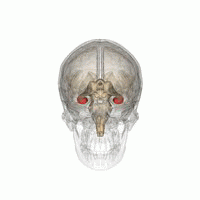
Photo from wikipedia
Objectives Structural neuroimaging studies have revealed a consistent pattern of volumetric reductions in both the hippocampus and the anterior cingulate cortex (ACC) of individuals with a major depressive episode (MDE).… Click to show full abstract
Objectives Structural neuroimaging studies have revealed a consistent pattern of volumetric reductions in both the hippocampus and the anterior cingulate cortex (ACC) of individuals with a major depressive episode (MDE). This study investigated hippocampal and ACC volume differences in the elderly comparing currently depressed individuals and individuals with a past lifetime history of MDE versus healthy controls. Methods We studied non-demented individuals from a cohort of community-dwelling people aged 65 and over (ESPRIT study). T1-weighted magnetic resonance images were used to acquire anatomical scans from 150 currently depressed individuals, 79 individuals with at least one past MDE, and 310 healthy controls. We derived quantitative regional estimates of subcortical volume of hippocampus and ACC using FreeSurfer Software (automated method). Concerning hippocampus, we also used a manual method of measurement. General Linear Model was used to study brain volumes in current and past depression adjusting for gender, age, education level, total brain volume, and anxiety disorder comorbidity. Results After adjustment, current depression was associated with a lower left posterior hippocampal volume (F = 10.38, P = 0.001) using manual estimation of volume. No other significant differences were observed. A positive correlation was found between time since the last MDE and left posterior hippocampal volume. Conclusions The finding of left posterior hippocampal volume reduction in currently depressed individuals but not in those with a past MDE compared to healthy controls could be related to brain neuroplasticity. Additionally, our results suggest manual measures to be more sensitive than automated methods. Disclosure of interest The authors have not supplied their declaration of competing interest.
Journal Title: European Psychiatry
Year Published: 2017
Link to full text (if available)
Share on Social Media: Sign Up to like & get
recommendations!